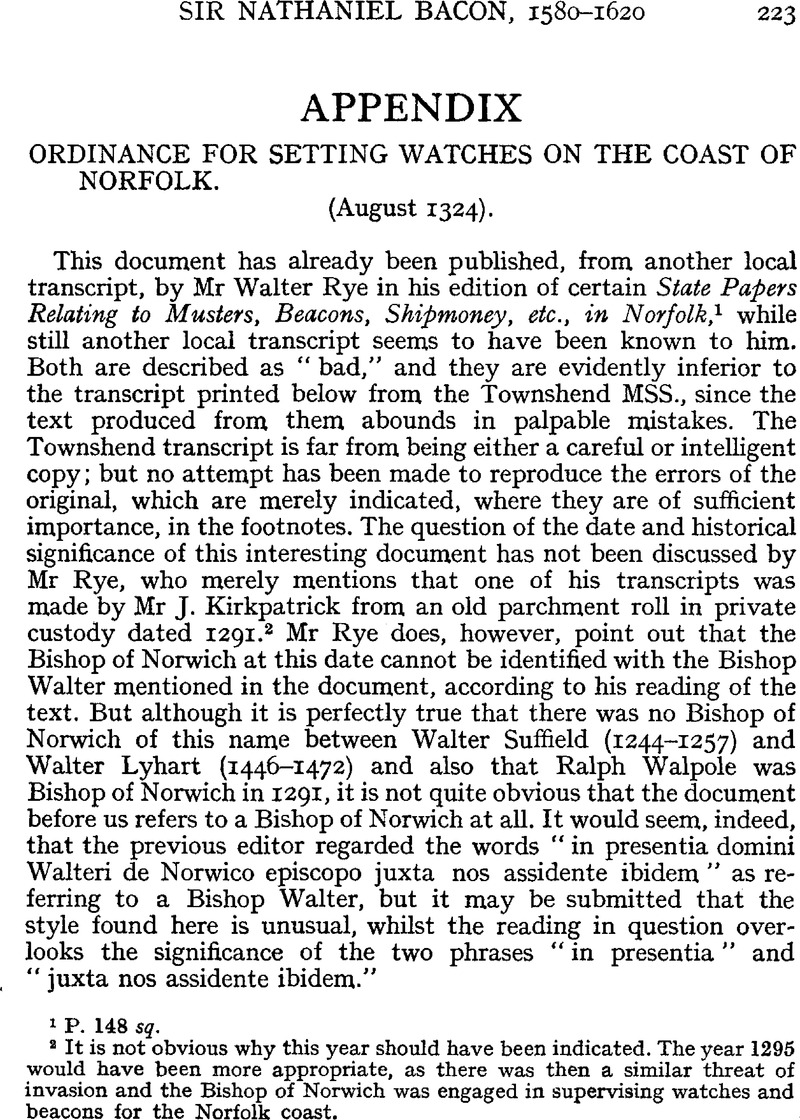No CrossRef data available.
Article contents
Ordinance for Setting Watches on the Coast of Norfolk
Published online by Cambridge University Press: 24 December 2009
Abstract

- Type
- Appendix
- Information
- Copyright
- Copyright © Royal Historical Society 1915
References
page 223 note 1 P. 148 sq.
page 223 note 2 It is not obvious why this year should have been indicated. The year 1295 would have been more appropriate, as there was then a similar threat of invasion and the Bishop of Norwich was engaged in supervising watches and beacons for the Norfolk coast.
page 224 note 1 He was himself a considerable landowner in the coastal hundreds.
page 224 note 2 Since this was in print the following references to Walter of Norwich have been kindly communicated by the Rev. William Hudson, M.A., F.S.A., from the conventual rolls in the possession of the Dean and Chapter of Norwich.
1301–2. Gifts to Walter of Norwich, clerk of the Exchequer, and to his clerk and groom.
1315. Gifts to the “family” of Sir Walter of Norwich and to the King's messengers and to Thomas Bardolf's grooms.
1321. Gifts to the groom of Sir Walter of Norwich and a servant of Sir T. de Bardolf.
page 225 note 1 Rot. Vase. 18 Ed. II. M. 29d. (Parliamentary Writs II. 660).
page 225 note 2 6 June 1324 (Parliamentary Writs).
page 225 note 3 See Færdera, Parliamentary Writs, and Calendars of Close and Patent Rolls, passim.
page 225 note 4 These instruments are printed in the Parliamentary Writs.
page 226 note 1 The topographical changes here referred to have been noted in the footnotes to the text. Four of the eight places which Mr Rye assumed had been washed away are here identified, but as the coast south of Winterton Ness has been subjected to considerable attack, especially to the South of Yarmouth, where probably both Sotibos and Fyrdouner were situated, it is most probable that these places are actually gone.
It seems almost impossible to reconcile the coast line with the measurements here given. The distances are reckoned in leucae, a term implying anything from the league of three miles to the statutory mile. It is used in the latter sense by Blomefield, but here it seems to have been the common mile of 2,000 yards. With liberal allowances for the windings of the coast line, this interpretation of the term is satisfactory as far as Winterton Ness. The distance, however, from Walcote to “Gruton in Mitford” (that is Gunton in Mutford) is given as 75 leucas (Winkesdale, which we cannot locate, being the intermediate stage) which on the former reckoning should be at least 20 leucas.
All the Hundreds of the County are mentioned and there seems to have been no change in their boundaries. The interesting point noted by the Rev. W. Hudson (Norff. Arch. Vol. XVII, Appendix B) is worth re-emphasizing. The Hundred of Gallow was the name of the Hundred bordering on the sea from Deepdale to Holkham and not, as now, Brothercross.
In Bowen's map of Norfolk (published 1749) the west boundary of Holt hundred starts from the mouth of the river Stiffkey, which empties itself into Cley or Blakeney harbour. Merston (that is, Morston) stands on the Thyrn, which also empties itself into Cley harbour, and Morston is here given as the boundary. This is probably a mistake of Bowen rather than any change which took place in the boundary.
page 227 note 1 Presumably the Commission of 23 July, 1324, referred to in the Introductory Note.
page 227 note 2 Custodia maris—Rye.
page 227 note 3 ? Clenchwarton.
page 227 note 4 iijd Rye.
page 228 note 1 4s., Rye.
page 228 note 2 Dersingham, Rye.
page 228 note 3 Mr Rye has Mundlebeck here, which, by reference to the next paragraph is evidently Mundesley.
page 229 note 1 A place which Mr Rye believes to be lost in the sea. Apparently it is Keswick, near Bacton.
page 229 note 2 Mr Rye has Happing, but Wastnesham =Waxton-esham=Waxham.
page 229 note 3 Places unknown to Mr Rye.
page 229 note 4 25., Rye.
page 229 note 5 sex, Rye.
page 230 note 1 Fier bones—Rye. Rectius Fire-bomes.
page 230 note 2 Per processus—Rye.


